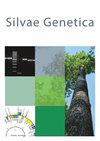新栎树叶绿体基因组CAPS单倍型鉴定标记的开发
IF 1
4区 农林科学
Q3 FORESTRY
引用次数: 3
摘要
我们的主要目的是产生成本效益高的叶绿体(cp) DNA标记,易于应用和评分。与已发表的cpSSR标记相结合,它们可以提高群体的单倍型分辨率。为了发现新的cpDNA标记,我们对覆盖范围为4,030X-6,297X的8棵栎树的叶绿体基因组进行了87- 97%(除第2个反向重复外)的测序,并以公开的栎树叶绿体基因组为参考进行了基因组序列的组合。共检测到118个单核苷酸多态性(snp)和107个插入或缺失(indels),并开发出15个cleaved amplified polymorphic sequence (CAPS)标记。利用这些新标记和5个叶绿体微卫星或简单序列重复(cpSSR)标记,我们在19个白桦群体的多样性面板中鉴定出10个单倍型。具体地说,基于cpSSR标记的两个单倍型现在可以被分离成五个单倍型。这些标记有助于高分辨率地评估单倍型多样性,并且也可转移到一个近缘种——椭圆栎。本文章由计算机程序翻译,如有差异,请以英文原文为准。
Development of novel Quercus rubra chloroplast genome CAPS markers for haplotype identification
Abstract Our main objective was to generate cost-effective chloroplast (cp) DNA markers that are easy to apply and to score. In combination with already published cpSSR markers they should increase haplotype resolution in populations. To discover new cpDNA markers, we sequenced 87-97 % of the entire chloroplast genome (except the second inverted repeat) of 8 trees representing different regions of the Quercus rubra L. natural range with 4,030X-6,297X coverage and assembled the genome sequences using the publicly available chloroplast genome of Quercus rubra L. as a reference. In total, 118 single nucleotide polymorphisms (SNPs) and 107 insertions or deletions (indels) were detected, and 15 cleaved amplified polymorphic sequence (CAPS) markers were developed for Q. rubra. Using these new markers together with five chloroplast microsatellite or simple sequence repeat (cpSSR) markers, we identified 10 haplotypes in our diversity panel of 19 Q. rubra populations. Specifically, two haplotypes based only on the cpSSR markers could now be separated in five haplotypes. These markers are useful to assess haplotype diversity with high resolution and are also transferable to a closely related species, Quercus ellipsoidalis E. J. Hill.
求助全文
通过发布文献求助,成功后即可免费获取论文全文。
去求助
来源期刊

Silvae Genetica
农林科学-林学
CiteScore
2.20
自引率
10.00%
发文量
10
审稿时长
3 months
期刊介绍:
Silvae Genetica is an international peer reviewed journal with more than 65 year tradition and experience in all fields of theoretical and applied Forest Genetics and Tree breeding. It continues "Zeitschrift für Forstgenetik und Forstpflanzenzüchtung" (Journal of Forest Genetics and Forest Tree Breeding) founded by W. LANGNER in 1951.
 求助内容:
求助内容: 应助结果提醒方式:
应助结果提醒方式:


